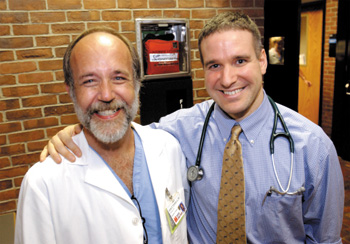
Rob Thomason, left, and Dr. Pete Swarr stand in front of one of eight AEDs located at VUMC. Swarr led the team who resuscitated Thomason after he collapsed. (photo by Dana Johnson)
Right place, right time — Respiratory therapist recovers after arresting while rushing to code
When Rob Thomason heard the stat call on June 3, he thought it might be a false alarm. It happens. People in the clinic faint all the time. This time, however, it was different. One stat call soon became two.
Rushing to the scene of the emergency, Thomason, a respiratory therapist in the Neonatal Intensive Care Unit, collapsed in the hall. The 46-year-old father of four suffered ventricular fibrillation and was dying.
Luckily for Thomason, he was in the company of people who knew what to do.
Third-year Medicine/Pediatric resident Drs. Pete Swarr and Emergency Medicine intern Tai Temple were 10 steps behind Thomason when he collapsed. Swarr directed Temple to stay with Thomason while he responded to the initial code in the clinic. Swarr quickly assessed the incident in the clinic and, after stabilizing the patient, rushed back to find Temple and others who responded to the emergency administering CPR to Thomason.
“I told someone to go down to the cafeteria and get the AED,” Swarr said. The AED is an automated external defibrillator, a lightweight, portable device used for people who have experienced cardiac arrest and have no pulse or respirations.
After several shocks and doses of epinephrine and atropine, Swarr and the team revived Thomason. He was rushed to the cardiac care unit, where he remained for five days. Thomason underwent angioplasty to clear right-side blockage.
Thomason is back at work full-time, less than seven weeks after the episode. His cardiac function is good, and he is currently enrolled in a three-month cardiac rehabilitation program at the Dayani Center.
“I was responding to a code in TVC…running down the hallway. That’s the last thing I remember,” Thomason said.
A smoker for many years, Thomason remembers tightness in his chest a few days before collapsing. Shrugging off the chest tightness like many do, Thomason knows he was lucky. His mother died from a heart attack at the age of 33.
“I’ve got a second chance. This has definitely changed my outlook on life,” he said. “If this would’ve happened anywhere else, I would be dead. I usually don’t respond to codes in that area. If I hadn’t done that, I would have gone home, mowed the yard or been on the lake when this happened.
“There are so many people I would like to thank. They all came together. I’m so grateful to everyone.”
Thomason’s wife, Cindy, a ECMO nurse based in the NICU, was working that day. She heard that Rob had collapsed and came running.
“I was crying too much to think,” she said. “I was wondering why he wasn’t responding and why it was taking so long. At times like this, seconds become hours.
“If it hadn’t been for where he was and who was there, he would be dead.”
She knows her husband beat the odds. He was lifeless for a critical six to eight minutes, when neurological damage usually begins to occur — a miracle Rob calls “divine intervention.”
As far as brain damage, Thomason has none. “At least no further damage,” he quipped.
Angel on his side
Swarr and Thomason, a 23-year veteran at VUMC, share a laugh while telling the story. The two have known each other for a while. “This guy taught me ventilator management,” Swarr said of his internship at VUMC.
“I didn’t know it was you,” Swarr said. “They pulled the mask away for the second intubation attempt and I looked down and said, ‘Oh my God, this is Rob!’
“You were a little different color than this. You were the color of your scrubs,” Swarr laughed, pointing to Thomason’s blue unform.
The mood turned serious, however, when Swarr talked about the device that gave Thomason a second chance.
“The AED saved your life,” he said. “That’s really the point here: having people who knew where the AED was and how to use it. You have an angel looking out for you.”
There are eight AEDs placed throughout the medical center and surrounding buildings. They are kept in red pouches and mounted in clear boxes on the walls. The device detects irregular heart rhythms and applies electrical shocks to the heart to regain an effective rhythm.
Almost anyone can use the device, not just medically trained personnel. “All you really have to do is turn it on,” said Les Wooldridge, manager of the Vanderbilt resuscitation program. “It talks to you and takes you through each step. It requires very little training.”
All residents, house staff and nurses are trained to use AEDs and are familiar with the location of each unit on campus.
The life-saving units can also be found throughout the community. In Nashville AEDs are housed at the Gaylord Entertainment Center, the Coliseum, the Nashville International Airport, area malls and a few restaurants. Firefighters and first responders also have the devices.
Studies have shown that people’s chance of survival decreases about 10 percent for each minute their heart isn’t beating and they aren’t breathing. AEDs, combined with CPR and early access to emergency care, increase survival rates almost 60 percent.
“Availability of AEDs improve survival from cardiac arrest more than almost anything else we can do,” Wooldridge said.
Also participating in Thomason’s resusciation were Dr. Sonya Collins, Amy Law, Gordon Perry, Dr. Beth Smitzer, Steve Steele, Dr. Hakan Sundell, Sherry Vance-Law and Jeff Wilson.













